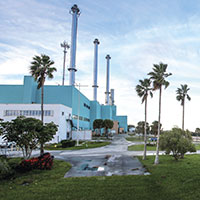 Fall vote possible on proposals for electric property
Fall vote possible on proposals for electric property
STORY
Now that the sale of Vero Electric seems back on track with the City Council voting 4-1 to pursue Florida Power & Light’s $185 million offer for the utility, officials have begun discussing in earnest what to do with the city’s last remaining buildable acreage on the Indian River Lagoon – and Vero Beach may hold a referendum on various options in November.
According to David Gay, the city’s chief surveyor, Big Blue sits on 17.4 acres with 620 feet of waterfront. The substation and switching equipment that will need to remain there take up about 1.1 acres on the northwest corner. The wastewater treatment plant across 17th Street sits on 16.3 acres with 500 feet of waterfront, not including the canal at the south.
Across the street from the wastewater plant is the parcel referred to as the “old postal annex” – another 4.6 acres on the southwest corner of 17th Street and Indian River Boulevard.
Together, these three parcels are being looked at as a whole, though they may be cleared for development years apart. The city’s Marine Commission and Recreation Commission have been looking at options for more than a year, hosting workshops and taking input from more than 300 members of the public.
“You can start if you know where you’re going,” Marine Commission Chair Thomas Juliano told the City Council. “The next step should be to engage a land design team to maximize the use of all three parcels.”
Councilman Lange Sykes said the city should go out to developers and others in the community and seek formal proposals to explore the financially viable options for making productive use of the land.
A short list of choices, he said, should then be placed on the November ballot for voters to decide. There was no major opposition to this concept, and City Manager Jim O’Connor said the City Council would need to act by August to get a referendum on the ballot. That would mean soliciting proposals and vetting them very soon.
Whether the proposals would be coming from developers, those pushing for the land to be a park, or nonprofit groups wanting the land for a specific use, the city needs to know exactly how much property would be available, and when.
Electric Utility Director Ted Fletcher said the timeline to complete the dismantling of Big Blue is 12 months, and that the city will actually make a $357,000 profit on the endeavor by selling salvaged material. That work will be done alongside the eight to 12 month process of relocating the control house switching equipment into the substation enclosure.
O’Connor said previously the city would bring in massive amounts of fill dirt to cover anything that doesn’t need to be removed. So if all goes well, by summer 2018 about 16 acres of the power plant property will be a huge, green lawn.
What to do about the sewer plant – a quandary the city has long kicked down the road – is now the burning question.
City utility staff and Councilman Dick Winger insist that the sewer plant is a profitable enterprise and should not be dismantled, moved or rebuilt at the Vero Regional Airport until the plant has served out its useful life – which will be in 2024, according to a consultant study – and the nearly $16 million debt, plus $2 million interest, is paid off.
Council candidate Val Zudans, a local physician who hopes to unseat Winger, sparred with him about this issue during the visioning workshop. Zudans said the sewer plant needs to come down as soon as possible – for both aesthetic and environmental reasons.
Several years ago, there was political pressure for Vero to sell its water and wastewater utility to Indian River County, eliminating the need for the riverfront plant. Most calls for that action ended when Vero gave its customers outside the city the same rates county customers pay. Based upon that, Vero inked another 30-year franchise agreement with Indian River Shores, solidifying the city’s position in the water-sewer business for decades.
Now, the city would have to either go into debt or drain its reserves to dismantle and move the plant to the airport, Water-Sewer Utility Director Rob Bolton said, noting that a 2011 study estimated the costs for that move at nearly $23 million.
But if the city stays in the water and wastewater business at the current location, it will have to keep very old equipment going well enough to meet ever-changing environmental standards, Bolton said.
“My best guess is that you will see some more stringent requirements on Wastewater Treatment Plant Nutrient Discharge in about 5 years or so. Whether or not they will affect Vero Beach or not, time will tell,” Bolton said. “If history repeats itself, there would be at least a 10-year window for compliance and probably would be more like 20 years.”
The Vero City Council will get an update on the Big Blue decommissioning and again take up the question of what to do with the valuable riverfront land at its June 6 meeting.








